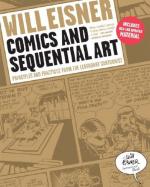
|
| Name: _________________________ | Period: ___________________ |
This test consists of 5 short answer questions, 10 short essay questions, and 1 (of 3) essay topics.
Short Answer Questions
1. What does the nature of lettering reflect about the artist?
2. As artists tell stories to mass audiences, what do they use as means of arrangement?
3. What conventions do comics rely on?
4. What method is the mainstay for facial expressions and body movement?
5. The sequential artist and the reader must share what kind of experience?
Short Essay Questions
1. Why are close-ups used when facial expressions are critical?
2. What happens to the hero in one of Eisner's Spirit stories who wishes he could fly?
3. What does communicating ideas involve?
4. What are used to move a reader/viewer through time?
5. Why is time more illusory in comics?
6. Give a brief summary of the historical evolution of comics according to Chapter 1.
7. How can stories can be told through imagery alone?
8. Give examples of different lettering techniques or styles from Eisner's story Contract with God.
9. What can the artist be tempted to compromise for the sake of attracting buyers?
10. How do people normally measure distance?
Essay Topics
Write an essay for ONE of the following topics:
Essay Topic 1
Eisner argues that comics and images can be "read." Explain the author's reasoning using two examples from the book. Defend or oppose Eisner's position.
Essay Topic 2
Eisner specifies a very organized procedure for comic writers and artists. Comic writers and artists must follow this procedure together. Discuss the idea and importance of teamwork in comics. Support your claims with two examples taken from any chapter.
Essay Topic 3
Since the artist controls the orientation of the reader/viewer's perspective, the artist functions somewhat like a director of the comic. Eisner goes even further to say that the panel functions as a stage. Discuss three ways in which the panel works as a stage. Use material from Chapter 4 to support your examples.
|
This section contains 687 words (approx. 3 pages at 300 words per page) |

|




